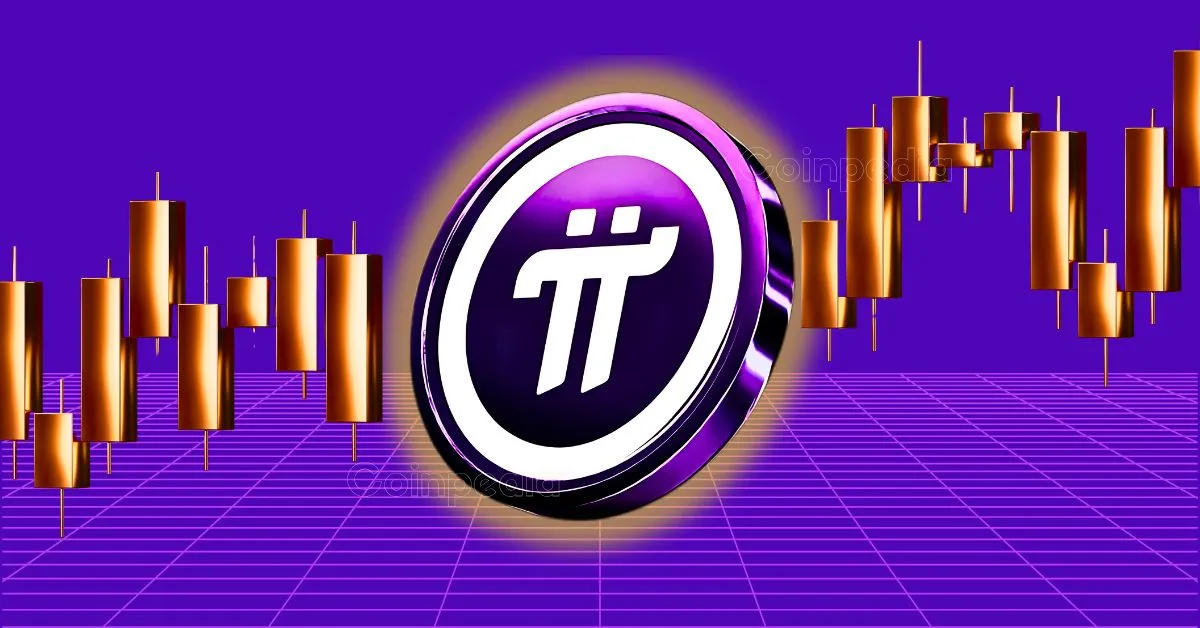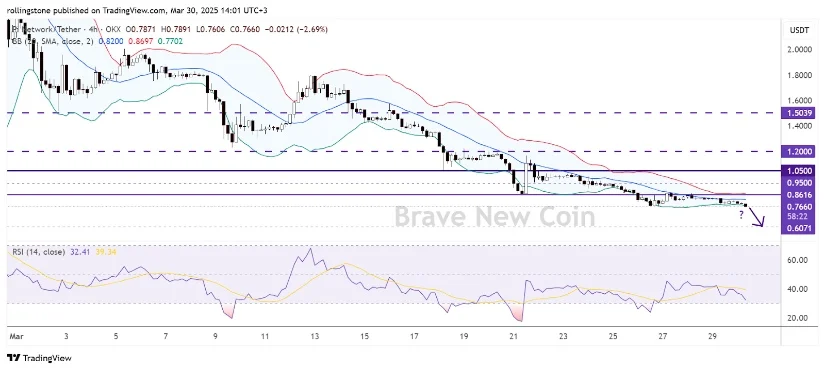Can Pi Network regain user trust in the face of Pi Coin’s 78% plunge just a few weeks after its launch and the prospect of additional token unlocks and delays?
Pi Network Pi Network in February pi
-4.92%
With the kind of hype that most cryptocurrencies can only dream of, Pi Network appeared on the scene. Pi Network’s long-awaited mainnet launch finally happened, and the token skyrocketed within days, reaching an all-time high of $2.98 on February. 26.
It even made the list of the top 10 cryptocurrencies by market cap for a brief time, competing with the industry’s giants.
However, if you fast-forward to April 2, the image appears significantly less glamorous. Pi Coin is currently trading at just $0.66, a 78% decrease from its all-time high just over a month ago. The crash has reduced its capitalization from nearly $20 billion to just $4.56 billion, erasing approximately $14.5 billion in market value.
- When we zoom out, the picture becomes even more hazy. According to PiScan, this month alone will see the unlocking of more than 124 million Pi tokens. And this is only the start. Unlocks per month will continue to rise, reaching a peak of 233 million in July.
- Over the course of the next year, a total of over 1.53 billion new tokens will enter the market, bringing the total circulating supply to 8.2 billion. That is a significant increase for a network with a supply of 6.7 billion and an objective cap of 100 billion. Pi is quickly becoming known as one of the most inflationary digital assets available at this rate. In the meantime, exchange support is still uneven. OKX was the first major platform to list Pi, followed by Bitget, Gate.io, MEXC, and Gate.io, which has the most trading volume at the moment. However, the token has not yet entered the majority of tier-1 exchanges. Bybit, Coinbase, Binance, and Kraken have all abstained. In fact, the CEO of Bybit went so far as to refer to Pi as a “scam,” a claim that its creators strongly refute.
- Consequently, what actually transpires behind the scenes of Pi Network? What can investors anticipate in the coming weeks and months, given that more tokens are expected to enter the market? Let’s dissect it. Errors, detours, and dead ends Issues that have less to do with market sentiment and more to do with operational breakdowns and silence from those in charge are the root cause of Pi Coin’s steep price drop.
- A single choke point, KYC, is one of the most frustrating aspects. The standard method of verifying a user’s identity, Know Your Customer verification, has become a nightmare for the numerous Pi Network users.
- This step must be taken. Users won’t be able to move their mined Pi tokens to the mainnet without it, which means they won’t be able to make transactions, withdraw funds, or access the value they think they’ve earned. Despite the Open Network’s launch on February 20 and the extended grace period for KYC and migration until March 14, the Pi Core Team has reportedly struggled to process the backlog for its estimated 60 million users.
- The goal of moving from Yoti, a third-party provider, to a proprietary KYC system was to make it easier to scale. However, technical issues like “Tentative Approval” statuses that stall progress have kept many users in the dark. There is a serious capacity issue, as some estimates indicate that only about 14 million users have successfully migrated.
- There are numerous first-hand accounts of Pi users struggling with this broken experience on social media platforms, particularly X. One user shared how her Pi coins were initially marked as migrated, then unexpectedly returned without any explanation, leaving her stuck in a loop of reconfirmations and waiting.
- My Pi was moved, and then it was marked as “Returned” without warning or explanation. I confirmed my migration wallet once more, and yet I am still waiting! Am starting to feel like this is all a scam.
- Another said that even though he was in the queue the whole time, his migration didn’t finish before the grace period expired, which resulted in him losing 1,427 Pi tokens.
The story of activity is different. The most recent attempt by Pi Network to demonstrate application in the real world was PiFest, a global merchant initiative held from March 14 to March. 21.
The event aimed to demonstrate how Pi could be used in practical settings, such as for groceries, clothing, car repairs, or digital services. It was framed as a campaign to encourage everyday adoption. Participation at the first Open Network PiFest was unprecedented. Over 125,000 registered sellers, including over 58,000 active sellers, and 1.8 million Pioneers have utilized Map of Pi, demonstrating the widespread application of the Pi in the real world. Inventors and… April 1, 2025 —
Pi Network (@PiCoreTeam) The reported figures appeared impressive on paper. Over 125,000 merchants, including 58,000 active sellers, signed up, and approximately 1.8 million Pioneers took part. However, actual network activity revealed a different picture beneath the scale.
According to on-chain data, there was little change in payment volume during the event. “The number of payments during the current #PiFest has not increased significantly,” as one user noted on X, suggesting that many users preferred to hold onto their tokens while there is still uncertainty regarding Pi’s future. #pinetwork #pi #picoin #minepi pic.twitter.com/3tP6vTrscK “The number of payments during the current #PiFest has not increased significantly, ultimately demonstrating that the community is either unhappy and unwilling to spend their $Pi or HODLing their Pi for the future.” The ecosystem’s deeper cracks can be seen in this hesitation.
Pi had previously committed to building a broad base of decentralized apps to keep users engaged beyond mining and peer-to-peer transfers.
Every step should be taken with caution. The most significant announcements were supposed to be made on Pi Day and on the anniversary of the sixth year.
Even the exchanges were ready to celebrate, but nothing happened—no major announcement, no 100 DApps! Third-party reviews, on the other hand, indicate that only a small number of dApps are currently operational, and even those that are operational lack significant utility in comparison to platforms like Ethereum. eth
-3.53%
Solana or Ethereum Solana sol
-4.75%
Solana. There is little incentive for daily token usage without a robust application layer. Pi’s planned integration with Telegram’s crypto wallet was one of its main strategies. The effort, which was initially promoted as a move to broaden reach, has not yet produced meaningful engagement or observable outcomes. Privacy concerns are also beginning to surface in the meantime. In Pi’s KYC system, users use selfie videos and ID checks to verify each other.
This is a community-driven process. Despite the fact that it was intended to scale access, this strategy carries risks. Users’ growing concern is that personal information could be exposed if redactions fail. Pi’s ecosystem still feels like a work in progress when taken as a whole. No matter how many users are technically onboarded, mainstream adoption will likely remain out of reach until the platform aligns real incentives for merchants, improves user confidence, and delivers functional apps. a turning point in the story A critical utility phase, as many in the crypto industry refer to it, has begun for Pi Network.
Real-world usage, developer activity, and ecosystem strength begin to determine whether a project will endure or fade away at this point, and hype alone no longer holds value. There are numerous cautionary tales in history. Projects like BitConnect, OneCoin, and even more reputable ones like NEM and Verge eventually failed due to a combination of lofty promises and subpar implementation.
The cycle usually happens again. It begins with user enthusiasm in the early stages and rapid valuation growth, progresses through delays in execution, and ultimately results in growing skepticism and a loss of faith. For investors, the months ahead will be key.
Concentrate on the chain’s happenings. Keep track of the actual number of wallets migrating, pay attention to the schedules for unlocking tokens, and don’t overly interpret price movements without considering the context. Any short-term rally is unlikely to last unless Pi can demonstrate genuine user activity, improved token management, and a more mature ecosystem.
https://lifelinesnewz.websiteAlways exercise caution when dealing with the market and never put in more money than you can afford to lose.





